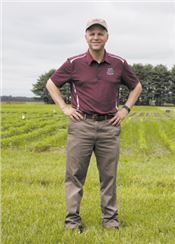|
Frogeye & SDS

Dr. Jason Bond, professor at Southern Illinois University, working in plant pathology discusses the two main soybean
diseases of frogeye leaf spot and sudden death syndrome.
Photo by John LaRose, Jr.
The Right Varieties, Fungicides Provide Soybean Disease Control
BETTY VALLE GEGG-NAEGER
MidAmerica Farmer Grower
BELLEVILLE, ILL.
Two main soybean diseases were topics under discussion recently by Dr. Jason Bond, professor at Southern Illinois University, working in plant pathology.
“One of those is a foliar disease called frogeye leaf spot which appears as little lesions on the leaves and it can be controlled by either deploying resistant varieties or by spraying fungicides,” he said. “The pathogen has become more aggressive in two main areas. It’s more aggressive on some of the varieties we’re planting so we have to make sure that we are using the right type of resistance. Also the pathogen is becoming more resistant to strobilurin fungicides that we’re spraying, so we have to be very careful about the type of fungicides that we spray.”
Bond also touched on a disease called sudden death syndrome (SDS), which has plagued farmers in Illinois since the 1980s. The preferred way to address this disease is by using post resistance. The United Soybean Board funds an annual commercial trial each year, and those trials are underway at multiple locations in Illinois and in Iowa.
“Those trials tell us which of the varieties farmers need to be using to control SDS in their field,” he explained. “We get this information in August and then we make it available to producers for their seed decisions for the next growing season.
“So the take home messages are there is resistance, and farmers have to be cautious in selecting varieties. From 2005 to 2009, 2011, 2014, if you look at those years you see a dramatic shift of germplasm in terms of the percentage of the varieties that are resistant to sudden death syndrome. The reason for that shift is because germplasm changes over time in terms of what varieties are being produced by producers,” he pointed out.
About 40 percent to 50 percent of the varieties that were tested in this region have some level of resistance to SDS, and that’s a good number. However, it’s not good enough to where you can just take random varieties out of a brochure. Bond urged caution in selecting varieties, because the resistance is there. Farmers need to be very deliberate in choosing the lines they will use.
“Back in 2011 when we did this trial we had much higher resistance, maybe 60 percent to 70 percent of the varieties were resistant to SDS,” he explained. “Those varieties we tested in 2011 aren’t being sold in 2014, so this change that we constantly see is the reason why these types of trials need to continue because it gives us an unbiased assessment of what is out in the commercial marketplace for producers.”
Bond honed in on some of the questions about the seed treatments that are available.
“That is kind of a revolutionary thing at least with regards to this disease,” he said. “The common seed treatments that we use both in corn and soybean, up until recently, have little to no impact on the pathogen that causes SDS. It is a soil borne Fusarium species but it does not respond to common fungicides that are put on seeds. Both Bayer and also Syngenta have new products, one is called ILeVO for Bayer and another is called Merteck for Syngenta. Both of those seed treatments have activity against this pathogen, so as the plant emerges the roots are protected two to three weeks by these fungicides that have activity against the pathogens.”
The treatment restricts the pathogen’s ability to get into the plant. Yes, the plant may become infected later, but the plant gets established to the extent that the infection that occurs later is subdued. The pathogen is not as effective at causing symptoms that are seen later in August, the typical time for SDS to appear.
“So we see a reduction of symptoms, we don’t see elimination of the symptoms,” Bond explained.
Another question was about putting fungicides in the furrow.
“Again the only things that have had activity that we have seen so far are the two products that I previously mentioned, and they work best on the seed,” he said. “It’s kind of interesting, you would think if you put more in the furrow you would get better control; but it’s the opposite of that. So the less active ingredient is actually better for the environmental component of the amount of fungicide that’s going out; but the less amount that’s going on the seed is really what’s giving us the control for that disease.” ∆
BETTY VALLE GEGG-NAEGER: Senior Staff Writer, MidAmerica Farmer Grower
|
|